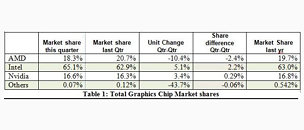Wednesday, February 19th 2014
Graphics Chip Shipments Up In Q4 2013, Intel and Nvidia Gain Market Share
Jon Peddie Research (JPR), the industry's research and consulting firm for graphics and multimedia, announced estimated graphics chip shipments and suppliers' market share for 2013 4Q. The quarter was the second quarter in a row to show a gain in shipments, up 1.6% quarter-to-quarter, and up 2% compared to the same quarter last year.
Quick highlights:
The popularity of tablets and the persistent economic slowness are the most often mentioned reasons for the decline in the PC market. The one bright spot in the PC market has been the growth of gaming PCs where discrete GPUs play a significant role. The CAGR for total PC graphics from 2013 to 2017 is -1.3% in 2013, 446 million GPUs were shipped and the forecast for 2017 is 422 million.
The ten-year average change for graphics shipments for quarter-to-quarter is -2 %. This quarter is 1.6% suggesting the market may have bottomed out and is slowly recovering-however, one quarter does not a market make, up or down.
Our findings include discrete and integrated graphics (CPU and chipset) for Desktops, Notebooks (and Netbooks), and PC-based commercial (i.e., POS) and industrial/scientific and embedded. This report does not include handhelds (i.e., mobile phones), x86 Servers or ARM-based Tablets (i.e. iPad and Android-based Tablets), or ARM-based Servers. It does include x86-based tablets, and x86-based Chromebooks.
The quarter in general
Graphics chips (GPUs) and chips with graphics (IGPs, APUs, and EPGs) are a leading indicator for the PC market. At least one and often two GPUs are present in every PC shipped. It can take the form of a discrete chip, a GPU integrated in the chipset or embedded in the CPU. The average has grown from 1.2 GPUs per PC in 2001 to almost 1.4 GPUs per PC.
Quick highlights:
- AMD's overall unit shipments decreased 10.4%, quarter-to-quarter, Intel's total shipments increased 5.1% from last quarter, and Nvidia's increased 3.4%.
- The attach rate of GPUs to PCs for the quarter was 137% and 34% of PCs had discrete GPUs that means 66% of the PCs are using embedded graphics.
- The overall PC market increased 1.8% quarter-to-quarter, but declined 8.5% year-to-year.
The popularity of tablets and the persistent economic slowness are the most often mentioned reasons for the decline in the PC market. The one bright spot in the PC market has been the growth of gaming PCs where discrete GPUs play a significant role. The CAGR for total PC graphics from 2013 to 2017 is -1.3% in 2013, 446 million GPUs were shipped and the forecast for 2017 is 422 million.
The ten-year average change for graphics shipments for quarter-to-quarter is -2 %. This quarter is 1.6% suggesting the market may have bottomed out and is slowly recovering-however, one quarter does not a market make, up or down.
Our findings include discrete and integrated graphics (CPU and chipset) for Desktops, Notebooks (and Netbooks), and PC-based commercial (i.e., POS) and industrial/scientific and embedded. This report does not include handhelds (i.e., mobile phones), x86 Servers or ARM-based Tablets (i.e. iPad and Android-based Tablets), or ARM-based Servers. It does include x86-based tablets, and x86-based Chromebooks.
The quarter in general
- AMD's shipments of desktop APUs (heterogeneous GPU/CPUs) jumped 15% from the previous quarter but declined 26.7% in notebooks. AMD's discrete desktop shipments increased 1.8%, and notebook discrete shipments declined 6.7%. The company's overall PC graphics shipments decreased 10.4%. Notebook build cycles are specific, and AMD was late with its new parts.
- Intel's desktop processor-graphics EPG shipments increased from last quarter by 5.2%, and Notebooks increased by 5.1%. The company's overall PC graphics shipments increased 5.1%.
- Nvidia's desktop discrete shipments were up 3.6% from last quarter; and its notebook discrete shipments increased 3.2%. The company's overall PC graphics shipments increased 3.4%.
- Year-to-year this quarter AMD's overall PC graphics shipments declined 5.4%, Intel increased 5.4%, Nvidia increased 0.9%, and Others fell 77% from last year.
- Total discrete GPU (desktop and notebook) shipments were up 1.5% from the last quarter and down 2.4% from last year for the same quarter due to the same problems plaguing the overall PC industry. Overall, the trend for discrete GPUs is roughly flat with a CAGR from 2013 to 2017 of-1.3%
- Ninety nine percent of Intel's non-server processors have graphics, and over 67% of AMD's non-server processors contain integrated graphics; AMD still ships integrated graphics chipsets (IGPs).
Graphics chips (GPUs) and chips with graphics (IGPs, APUs, and EPGs) are a leading indicator for the PC market. At least one and often two GPUs are present in every PC shipped. It can take the form of a discrete chip, a GPU integrated in the chipset or embedded in the CPU. The average has grown from 1.2 GPUs per PC in 2001 to almost 1.4 GPUs per PC.

14 Comments on Graphics Chip Shipments Up In Q4 2013, Intel and Nvidia Gain Market Share
Dual Graphics on 1366x768 screens, 1066MHz RAM, bulky laptop designs... and when the design is good the price goes above Intel.
AMD needs to bark on their partners in order for them to make proper notebooks with their chips.
EDIT: or paying them off. Perhaps the disappointing power consumption and performance of Trinity chips turned off manufacturers to making them?How is that silly? if gamers avoid the r9 gpu's due to the inflated prices, and purchase an NVIDIA chip this generation, then that would be bad for AMD. supposedly, (At the moment, I cant find the article that stated this, so it may be rumor) when the 5950 and 5970 came out, AMD recieved kickbacks from retailers when they hiked prices. whose to say that is not happening again?
www.pcper.com/news/General-Tech/AMD-Radeon-R9-290X-Hits-900-Newegg-Thanks-coin